SiFive Announces First RISC-V OoO CPU Core: The U8-Series Processor IP
by Andrei Frumusanu on October 30, 2019 10:00 AM EST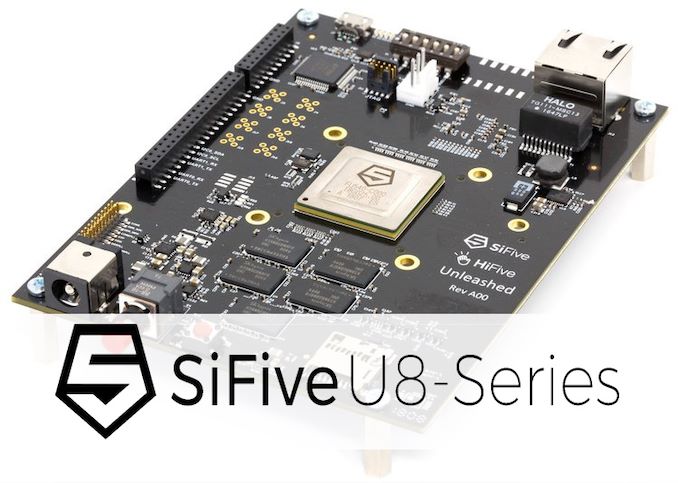
In the last few year’s we’ve seen an increasing amount of talk about RISC-V and it becoming real competitor to the Arm in the embedded market. Indeed, we’ve seen a lot of vendors make the switch from licensing Arm’s architecture and IP designs to the open-source RISC-V architecture and either licensed or custom-made IP based on the ISA. While many vendors do choose to design their own microarchitectures to replace Arm-based microcontroller designs in their products, things get a little bit more complicated once you scale up in performance. It’s here where SiFive comes into play as a RISC-V IP vendor offering more complex designs for companies to license – essentially a similar business model to Arm’s – just that it’s based on the new open ISA.
Today’s announcement marks a milestone in SiFive’s IP offering as the company is revealing its first ever out-of-order CPU microarchitecture, promising a significant performance jump over existing RISC-V cores, and offering competitive PPA metrics compared to Arm’s products. We’ll be taking a look at the microarchitecture of the new U8 Series CPU and how it’s built and what it promises to deliver.
As a bit of background on the company, SiFive was founded in 2015 by the researchers who invented the RISC-V instruction set at UC Berkeley back in 2010. The company’s goal was to develop and implement CPUs and IP based on the RISC-V ISA and produce the first hardware based on the technology. The company first full-blown CPU IP that was able to run a full OS such as Linux was the U54 series which was released in 2017, and ever since SiFive has been in an upward trend of success and hypergrowth.
Introducing the U8-Series - A Scalable Out-of-Order RISC-V CPU Core
Up until now, it’s been relatively unsurprising that if you’re designing a new CPU based on a new ISA, you first start out small and then iterate as you continue to add more complexity to your design. SiFive’s U5 and U7 series as such have been relatively more simplistic in-order CPU microarchitectures. While offering functionality and being very cost-effective options and alternatives compared to Arm’s low-end and microcontroller cores, they really weren’t up to the task of more complex workloads that needed more raw performance.
The new U8-Series addresses these concerns by massively improving the performance that can be delivered by the new microarchitecture – outpacing the U54 and U74 by factors of up to 5-4x, a quite significant performance jump that we don’t usually see very often in the industry.
The new CPU IP’s performance promises to vastly expand SiFive’s and the RISC-V’s ecosystem viability in end-point products, and really be able to offer alternatives to the embedded Arm products in the world today and in the future.
SiFive’s design goals for the U8-Series are quite straightforward: Compared to an Arm Cortex-A72, the U8-Series aims to be comparable in performance, while offering 1.5x better power efficiency at the same time as using half the area. The A72 is quite an old comparison point by now, however SiFive’s PPA targets are comparatively quite high, meaning the U8 should be quite competitive to Arm’s latest generation cores.


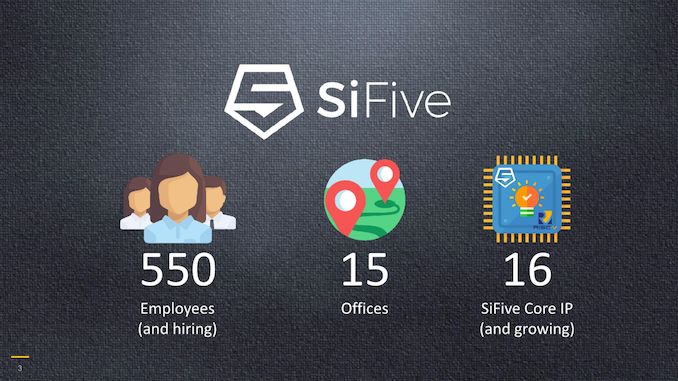

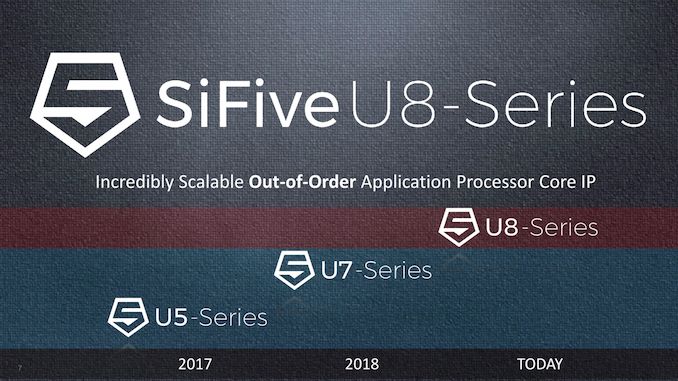
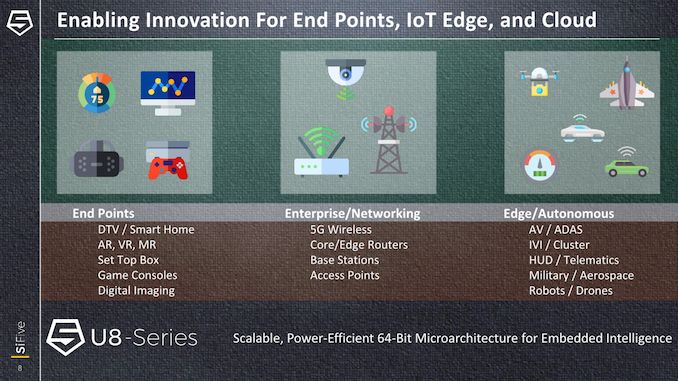
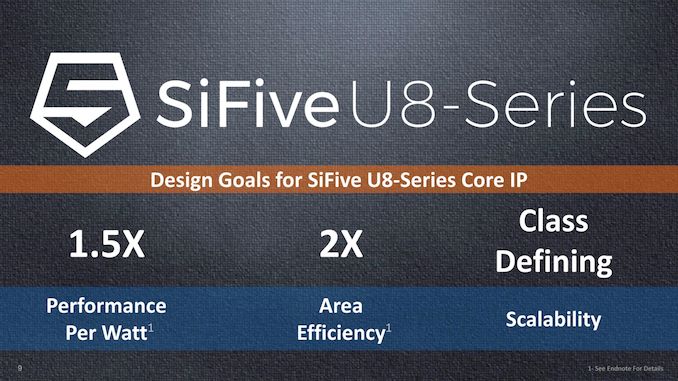








68 Comments
View All Comments
vladpetric - Thursday, November 7, 2019 - link
You're right. RISC-V SIMD, as opposed to classic SIMD, is really something to be excited about.I really disagree about auto-vectorising though, unless we're talking about FORTRAN code.
The parent post implied that not having classic SIMD in RISC-V is something of a showstopper.
ravyne - Wednesday, October 30, 2019 - link
If their business was selling physical cores, you might have a point, but like ARM they're an IP company. But unlike ARM, adopters don't need an expensive architecture license to develop their own cores, and unlike ARM the architecture is designed for adopters to extend, with well-defined rules for operation encoding to do so. Early adopters are building their own cores, some with standard cores, but many with their own core designs or ISA extensions that would be impracticle in ARM's ecosystem. One of the reasons that companies don't really extend ARM is that you'd need a new ARM architecture license if ARM changes (as they did with ARMv8, say) and now you want to bring your investment forward -- you've locked yourself in to ARM licensing cost, and you're in a hard spot if you don't like the way ARM moves next.It's also worth noting that RISC-v has taken a lot of time to do their vector ISA right -- not only is the vector ISA homogenous and complete (every suitable scaler op has a vector equivalent) but it's structure is programmer-centric and forward-compatible -- that is, you write the vector code using the appropriate ALU width for the problem, and the CPU runs it across the full vector width it actually has. If you run your vector code on a machine 2 years from now and the vector unit is twice as wide, that same code runs twice as fast, and perhaps twice as fast again in two more years. Or 16 times faster next year on a specialized RISC-V vector accelerator. This is so much better than traditional SIMD ISAs like AVX/SSE/MMX, Altivec, or NEON -- if Intel had done this with their vector ISA, original SSE code would run 8-16 times faster today, instruction-for-instruction.
You scoff at where they are 5 years in, but where they are is competitive with ARM's own current IP. The industry momentum shown by that and the ecosystem buildup around risc-v is incredible.
Wilco1 - Wednesday, October 30, 2019 - link
"where they are is competitive with ARM's own current IP"It might match performance of a 4.5 year old Cortex-A72 next year, maybe (*). But that's nowhere near being competitive with Arm's current IP... Arm sells much faster and more efficient cores like Cortex-A77.
(*) It's easy to make bold claims in marketing, let's see how it performs in the real world.
quadrivial - Wednesday, October 30, 2019 - link
Most cellphones sold today are still using 4 or 8 A53 cores. A core that gets better performance in less die area is sure to attract some notice.More to the point, my raspberry pi 4 with 4x A72@1.5GHz along with a crappy SD card and 4GB of slow, single-Lane RAM is almost fast enough for daily use doing normal consumer things and light software development. 4 of these cores at almost twice the speed paired with slightly better IO and RAM is probably all the more computing most people need.
Wilco1 - Thursday, October 31, 2019 - link
It would be hard to find a niche that Arm hasn't already covered. Remember that both Cortex-A53 and A72 have fast dual floating point units as well as SIMD, but the U8 doesn't include SIMD, so any area comparisons are going to look great for the U8.name99 - Wednesday, October 30, 2019 - link
Parts of the RISC-V community have been investigating an instruction set that looks like SVEhttps://content.riscv.org/wp-content/uploads/2018/...
But that seems to have got entangled with a DIFFERENT research concept (namely run the vector engine asynchronously from the rest of the CPU), which certainly can't help with getting the ideas in commercial production on time.
I've no idea how this will play out
- full Hwacha (SVE + decoupled execution)
- Hwacha as a "normal" sort of instruction set, like SVE, or
- commercial partners settle on a smaller NEON-like instruction set to get basic SIMD up and running.
Samus - Wednesday, October 30, 2019 - link
This is obviously a application specific product and not meant to be as universal as ARM or off the shelf RISC SoC's.It seems their edge is in having efficient execution units to reduce power consumption so this will be good for ultra low power devices that still need decent performance.
cpuaddicted - Wednesday, October 30, 2019 - link
You mean not unlike the SVE capable ARM chips available today? lolSamus - Thursday, October 31, 2019 - link
How is SVE even remotely comparable to this? An extension to ARM still has the inherent 'flaws' of ARM. That its RISC. Adding x64, SSE, SVX, VX, etc to x86 didn't change that fact its still x86.You clearly lack the foresight to see this company has a (niche) product that fills a gap in the market.
bcronce - Wednesday, October 30, 2019 - link
Ideal RISC does not support SIMD because one of the requirements of RISC is a single instruction does a single operation. SIMD "Single Instruction Multiple Data" is antithetical to that. Even the RISC-V designers view SIMD/VectorProcessing as a necessary evil and purposefully keep it limited.